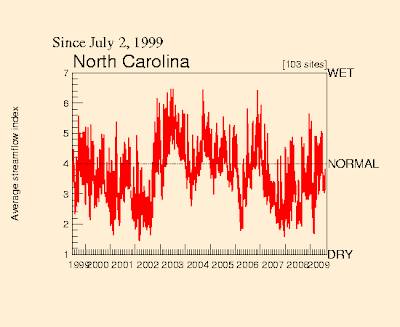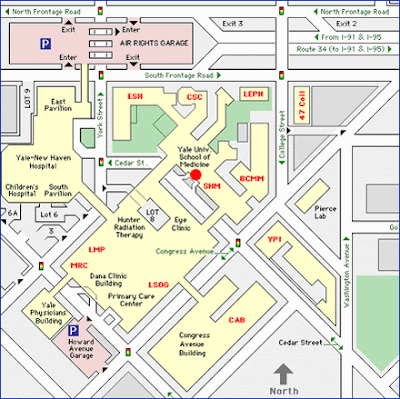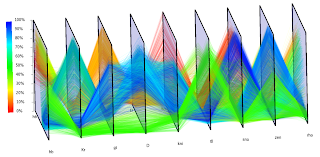
Blog Archive
Tuesday, August 4, 2009
Parallel Coordinate Graph

Accumulative Line Graph
Correlation Matrix
Index Value Plot
Cartographic Map

Mapping has been around for many many years, and cartographic maps can be images depicting various numbers of things. Cartographic maps are not necessarily maps of physical features, but can also show cultural boundaries. The map seen above was a cartographic map of what inhabitants thought the world looked like and therefore documented it as such.
Planimetric
Star Plot
Thursday, July 30, 2009
Stem and Leaf Plots
Wednesday, July 29, 2009
Population Profile
Box Plot
Histogram
Triangular Plot
Windrose
Climograph
Tuesday, July 28, 2009
Scatterplot
Univariate Choropleth Map
Bivariate Choropleth Maps
Bilateral Graph
Classed Choropleth Maps
Saturday, July 25, 2009
Unclassed Choropleth Map
Range Graded Proportional Circle Map

Continuously Variable Proportional Circle Map
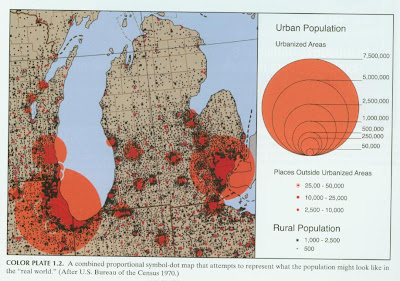
A Continuously Variable Proportional Circle Map is a type of point pattern map. Proportional circle maps plot data with circles as opposed to dots and the size of the circles are representative of the data being plotted. The map shows the urban population in Michigan using various proportional circles.
DOQQ
DEM
DLG
DRG
Monday, July 20, 2009
Isopleths
Isopach
Wednesday, July 15, 2009
Isohyets
Isotach
Isobars
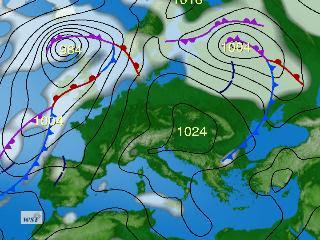
An isobar is a contour line that is used to depict a constant pressure in meteorology. This image is showing the barometric pressure in Europe as well as over the Mediterranean sea. Once you identify a pressure with a certain spot on a line, you can then follow that line and along the entire line it will be the same pressure.
Hypsometric Map
PLSS
Cadastral Map
Monday, July 6, 2009
Topographic Map
Friday, July 3, 2009
Infrared Aerial Photo
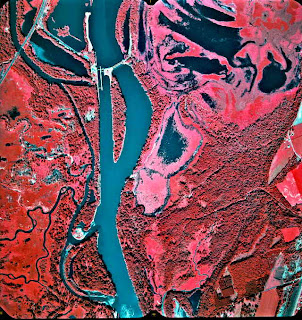
This infrared photo is a shot of the upper Mississippi River. Infrared emulsion is more sensitive to wavelengths that the human eye cannot see. The wavelengths are not truly red, but modified so that we may see them. In certain situations, it may be easier to distinguish details using infrared as opposed to the same black and white photo.
LIDAR
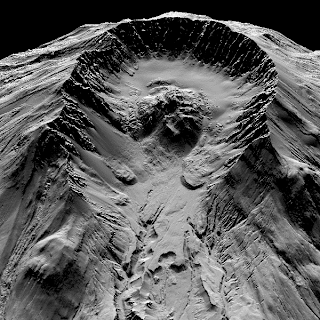
LIDAR, which stands for Light Detection and Ranging, is one of many remote sensing tools. LIDAR specifically uses laser, which is light amplification by stimulated emission of radiation, instead of radio or microwave radiation. The above photo is of a crater. LIDAR is a common tool used by the military in determining distances between areas.
Doppler Radar
Statistical Map
Black and White Aerial Photo
Wednesday, June 10, 2009
Cartogram
Propaganda Map

The image above is a form of a Propaganda Map because it takes information that is not necessarily fact and portrays it in a way as if it is truth to sway the minds of others. Propaganda Maps have been used for many years by all countries in war, political battles, and social conflicts. This particular map is a picture of a man who is in clear opposition of the republican party in America and therefore portrays information in a way that may make others favor his similar views.
Monday, June 8, 2009
Proportional Circle Map

This Proportional Circle Map is indicating the Mexican population within the western United States in 1990. The various sizes of the circles indicate the population size within particular areas. Also as a Thematic Map the proportional circles reflect we see the theme of Mexican population across the entire area.
Choropleth Map

The map above is an example of a Chloropleth map which summarizes the distribution of a particular topic, in this case millions of dollars spent by overseas residents across Great Britain. The distribution data is based on specific boundary lines as indicated in the image. Chloropleth maps are another sub-category within Thematic Maps.
Friday, June 5, 2009
Flow Map
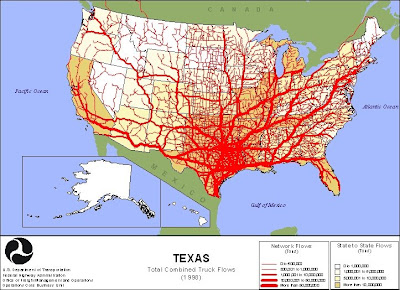
Again, a subcategory of Thematic Maps, Flow Maps in particular show the movement between places. The map above is showing the movement of trucks across the U.S put out by the department of transportation. The different thickness in the lines indicates the quanity of flow of trucks. With an increase in thickness, the key indicated that this means an increase in the number of trucks moving from point A to point B. While that was the main focus of posting this example, the map above also a choropleth map with different shades of color indicating volume of flow state to state.
Monday, June 1, 2009
Isoline Map

An Isoline Map is also a type of Thematic Map but in this case uses lines as a means to represent the data at hand. A line is drawn connecting different points of equal value. The above map shows data of pressures across the U.S, and here we see lines drawn in for all points containing equal pressure. Because of how the pressures form, this data allows the lines to create circles, but this is not necessarily always the case.
Dot Distribution Map
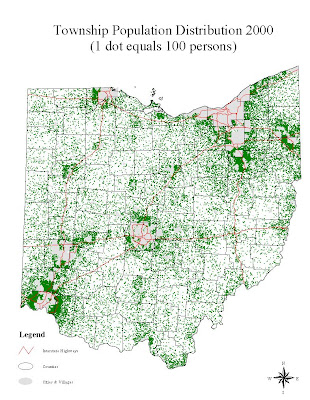
A Dot Distribution Map is also a form of a Thematic Map, specifically using dots however to portray the data. This particular image is mapping the population distribution across Ohio. Areas of thick dots which seem to blur into a large green splotch, are areas of high density. Again, this is simply a plain base map of all townships within the state with population data superimposed over top of it.
Mental Map
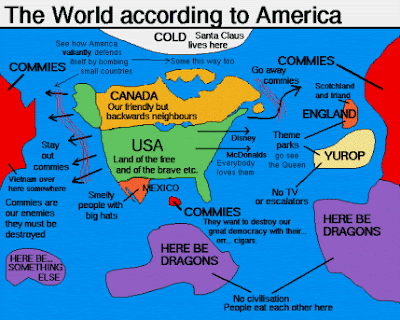
The map above represents an example of a mental map. A mental map is the way a particular person or group of people, in this case referring to the entire United States of America, views information or a particular situation. The image humorously pokes fun at how Americans view the rest of the world focusing on the idea that America is the best place to be. While every individual has their own personal mental map of whatever is being discussed, this image groups a very large population together and states that this is what all Americans think. Of course one must always consider than each individual still has their own view.
Friday, May 29, 2009
Thematic Map

This particular map is a Thematic Map because as the name suggests, it represents a theme about a certain area. A Thematic Map shows information about a particular subject superimposed over a base map. In this case, the image is reflecting the population change across America over a six year span. Many different sets of data can be represented in the form of a thematic map, and there are several types of thematic maps. Often maps can be labeled thematic in what they're representing as well as another kind of map in how the information is being reflected.
Subscribe to:
Posts (Atom)



